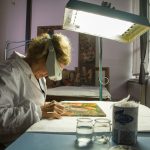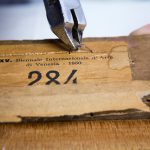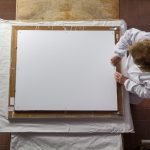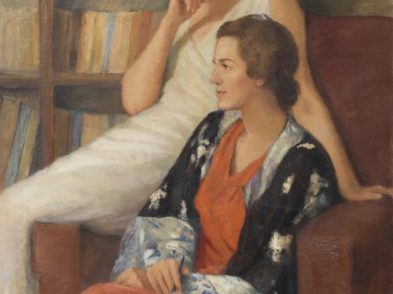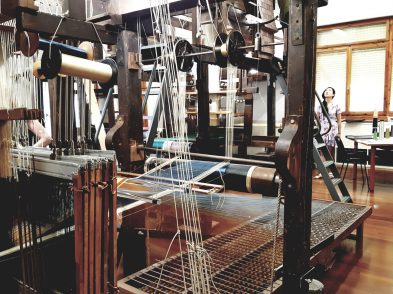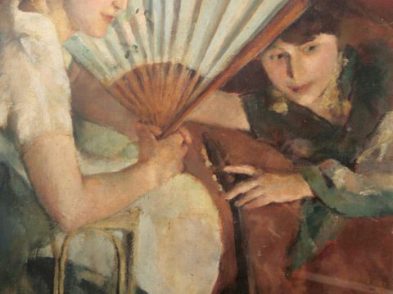On November 4, 2016, Florence’s Twentieth-Century Museum will inaugurate an exhibition featuring works by multiple artists who gifted art to Florence after the 1966 flood to show their support for the damaged city. These works were given on the promise that they would become part of International Contemporary Art Museum, which was inaugurated 48 years later as the Museo Novecento. Though nearly 40 works by women continue to remain in storage, seven paintings and sculptures by women artists have just been restored by the Advancing Women Artists Foundation. They will take their well-deserved place in the museum spotlight during a forthcoming exhibition. Here’s how these works came to call Florence home.
Home Sweet Florence
Art historian Carlo Ludovico Ragghianti masterminded the “Artists for Florence” plea, which garnered a response from English painter Daphne Maugham (1897–1982), Felice Casorati’s wife, whose plein-air In the Garden is an almost Impressionist example of what her husband most admired in the artist: her ability “to paint with simple joy”. German-born sculptress Genni Mucchi (1895–1969)—whose work is often an expression of social protest or a denouncement of political violence—also donated a work, as did Edita Broglio (1886–1979), the Latvian co-founder of Valori Plastici, a short-lived but fundamental art journal that called for “a return to order”, or the rediscovery of fourteenth- and fifteenth-century aesthetic principles.
The Cubans
Following Palazzo Vecchio’s 1967 art show “I cubani”, over forty Cuban artists requested that the City of Florence sell their exhibited pieces and use the funds to restore flood-damaged art. Their
intentions failed to reach fulfillment. The collection includes a Cubist-like still-life work by vanguard painter Amelia Peláez (1896–1968), whom MOMA founder
Alfred H. Barr credited “for bringing Latin American Art into the Twentieth century”. Workers on Lunar Craters by Lolo Soldevilla (1901–71) is a fine example of
geometric abstractionism, while Rita Longa’s (1912–2000) small wooden sculpture, Gray Bird, is a unique abstract departure from her usual iconic large-scale sculptures, epitomized by her famed Ballerina, which, in Havana, is nearly as famous as the mambo-haven it represents:
Club Tropicana.
The Artists of Belgrade
The gifted works of Serbian artists spent almost two years in customs before reaching Florence in 1970. This 62-piece collection boasts a painting by landscape artist Vera Boéziéckoviâc-Popoviâc, whose works were opposed by ex-Yugoslavian state and party leader Tito, because part of the Art Informel movement, which he declared “a decadent phenomenon”. A key exponent of post-war modernism in Belgrade in the 1960s, Boéziéckoviâc-Popoviâc produced works that have been described as “Too obvious to be seen, they show the impotence of the eye.” (Lazar Trifunovic).
“I give you my life”
In 1970, Ragghianti completed negotiations with eclectic Genoa-based art collector Alberto della Ragione, who wrote about gifting Florence his 241-piece collection in an open letter printed in La Nazione, calling the gesture “a testimony of affection for Florence, tremendously wounded by the flood of 1966, as well as an act of adherence to the efforts being made to restore the city’s role of living capital of the arts.” The gift included a statue of the collector’s mother created by Jewish-Lithuanian sculptor Antonietta Raphael Mafai, co-founder of the Scuola di Via Cavour. Her movement was an offshoot of the more all-encompassing Scuola Romana, which brought together revolutionary artists between the two World Wars, intent on making a break from Mussolini’s cannons for regime-supporting contemporary art. This varnished bronze portrait of Signora della Ragione will become part of the museum’s permanent collection.
Beyond Borders. After the Flood: the Artists’ Engagement
Dopo l’alluvione: l’impegno degli artisti.
Until January 8, 2017
Museo Novecento, piazza Santa Maria Novella, Florence

